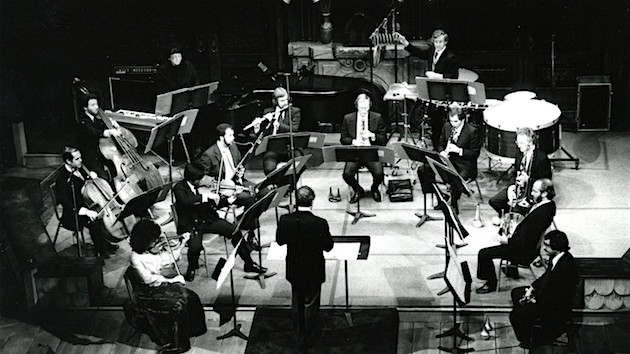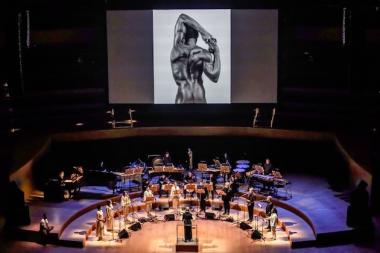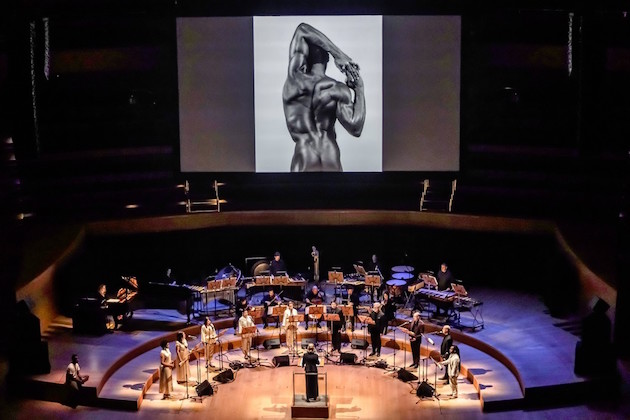
We’ve come a long way since July 26, 1989, when Senator Jessie Helms proposed Amendment 420 to restrict funding for the National Endowment for the Arts, declaring “My amendment would prevent the NEA from funding such immoral trash in the future.” He was reacting to an exhibition of explicit photographs by Robert Mapplethorpe depicting New York’s gay BDSM leather scene.
At Tuesday night’s premiere of Bryce Dessner’s musical homage to Mapplethorpe, Triptych (Eyes of One on Another), performed by the 10-member vocal ensemble Roomful of Teeth and members of the Los Angeles Philharmonic New Music Group, there wasn’t so much as a twitter when Mapplethorpe’s leather-scene depictions filled the screen above the stage.
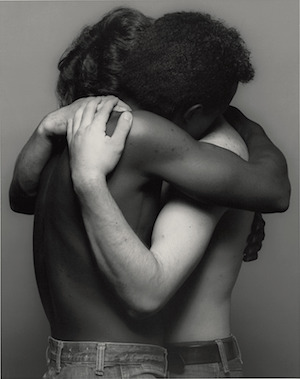
Why was that? Certainly, we have grown more accepting of alternative life-styles. We can even thank Fifty Shades of Grey for making BDSM an acceptable subject for book clubs and sophisticated cocktail banter. BDSM (gay or straight) is now mainstream, especially to contemporary arts audiences. San Francisco Mayor London Breed, recently signed legislation to establish a public plaza (in the Folsom district) dedicated to the “Strong cultural influence” of the leather/fetish community. Tear down a dungeon, put up a parking lot.
It was also the way Dessner approached his subject that made the audience feel safe in their comfort zone. Beautifully crafted and performed though it was, Dessner’s music for Triptych never takes risks. He employs a musical vocabulary of cool post-minimalism (akin to David Lang) combined with the fervor of gospel, spirituals, and American folk music, as he does in his Murder Ballads.
Instrumentally and vocally Dessner interprets the beauty of Mapplethorpe’s black and white photography by incorporating what might be called a “zone system of harmony.” Like Ansel Adams, he creates a full spectrum of tonalities from the deepest black shadows to blazing white highlights. He bends vocal and ensemble lines so they modulate above, below, and around the principal note, while adding extended vocal techniques that sound like fluctuating sound waves and scrapping metal. The work is scored for vocal ensemble, string trio, bass clarinet, horn, piano, and expanded percussion.
What’s missing is any sense of danger and the adrenalin rush that comes from tasting forbidden fruit — an addiction that ultimately proved fatal to Mapplethorpe, as it did for his fellow sub-culture explorer, Diane Arbus.
As the title implies, the work is divided into three sections (X, Y, and Z). The libretto (which, unfortunately, is not projected) incorporates poems by Mapplethorpe’s female muse Patti Smith, as well as poems by Korde Arrington Tuttle and Essex Hemphill. It also includes extracted material from the 1990 obscenity trial (a year after Mapplethorpe’s death from HIV/AIDS).
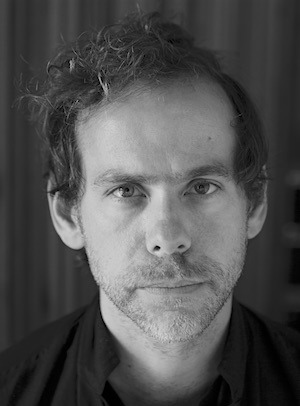
He recalls coming away with the impression that Mapplethorpe was a mannerist in the style of Michelangelo and Caravaggio. And it is this sense of cool classical symmetry and balance that permeates Triptych.
Presented in a concert format in Los Angeles, prior to fully realized stagings to come, the singers of Roomful of Teeth were arranged in a semicircle with the musicians behind and a massive screen for the projection of the photographs above.
As conducted by Sara Jobin, the piece establishes its classical roots at the very beginning with a reinterpretation of Monteverdi’s song to a dead lover, “Incenerite spoglie” (Ashes of my beloved). Dessner’s vocal lines blend his own harmonies with Monteverdi’s polyphony. It works as an effective lead in to Patti Smith’s poem “The Boy Who Loved Michelangelo,” though it’s unlikely the audience could understand many of the lyrics. The overamplification of the singers didn’t help, adding a high-volume sheen to the voices and causing an imbalance with the instruments.
Part 2 focuses on the trial, with the singers repeating the case number like the mathematical equations in Einstein on the Beach. Part 3 is devoted to Mapplethorpe’s portraits of African Americans, with mezzo-soprano Alicia Hall Moran providing a testimonial gospel flavor. Ironically, the portraits are some of Mapplethorpe’s least interesting creations. It all ends with a bizarre, overstated anthem proclaiming in an ever-rising chorus “America, place your ring on my cock where it belongs.” Really?
